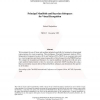413 search results - page 19 / 83 » Face recognition using mixtures of principal components |
ICCV
1999
IEEE
13 years 12 months ago
1999
IEEE
We investigate the use of linear and nonlinear principal manifolds for learning low-dimensional representations for visual recognition. Three techniques: Principal Component Analy...
ECCV
2000
Springer
14 years 9 months ago
2000
Springer
In recent years several techniques have been proposed for modelling the low-dimensional manifolds, or `subspaces', of natural images. Examples include principal component anal...
CVPR
1999
IEEE
14 years 9 months ago
1999
IEEE
Facial variation divides into a number of functional subspaces. An improved method of measuring these was designed, within the space defined by an Appearance Model. Initial estima...
AVBPA
2003
Springer
14 years 27 days ago
2003
Springer
We present a novel 3D face recognition approach based on geometric invariants introduced by Elad and Kimmel. The key idea of the proposed algorithm is a representation of the facia...
CVPR
2008
IEEE
14 years 9 months ago
2008
IEEE
Parameterized Appearance Models (PAMs) (e.g. eigentracking, active appearance models, morphable models) use Principal Component Analysis (PCA) to model the shape and appearance of...

